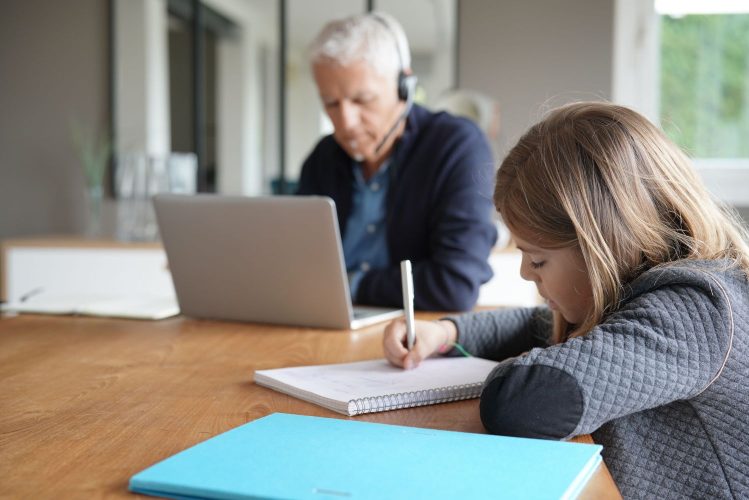Children, regardless of their age, naturally look to their parents for guidance and cues for how to respond, especially during high stress times. Taking care of yourself and starting with your own reflection is beneficial for the whole family.
Self-Regulation
It is natural for us to experience all sorts of emotions, especially as we are trying to swiftly adapt to changes in our own work situations, meeting household demands, and simultaneously trying to meet the needs of our children. Our brains are wired to help us survive. However, in order to make rational and less reactive decisions, we must calm our brains and bodies. This also carries over to our children; when their minds, bodies, and hearts are calm and they feel safe, they are ready to learn.
The protective mind (aka negative mind) may immediately and automatically release a lengthy list of fears and scenarios of all the things that can go wrong during this time of high stress and uncertainty, thus sending your nervous system into a fight, flight, or freeze response. You can start to find calm and stay connected with your body by thanking your protective mind for showing up to help you. Notice what your protective mind wants to tell you. Do not dismiss it; your protective mind has a lot of experience and wisdom. You might consider making a list of the concerns that show up. Then, from a place of curiosity, ask your protective mind what it needs you to do to feel calm, capable, safe, and connected.
- Try this: Ground your body, anchoring yourself to the present moment by bringing your attention to the rhythm of your breath, a sound inside or outside the room, your body being held by the chair, sofa, or whatever you are resting on. Take inventory of the colors or smells in your room. Remind yourself, “I am safe, connected, and capable.”
Role Clarification
Our job as parents is to continue to be the parents during this time of change. What our children need the most is to feel connected to us. Research on resilience has consistently shown that when faced by life-threatening situations, children fare best when their parents are able to stay calm, focused, and optimistic. Practice discernment; make a decision and commit while remaining flexible to new developments. This will allow you to model healthy emotional regulation and problem-solving, regardless of your child’s age. For our children who have social cognitive impairments, it is helpful to talk about our process and steps. For instance, “Given what I know, classes have been moved to online instruction until mid-April. Let’s proceed with a temporary plan that includes a daily schedule posted in the dining room…,” etc.
Supporting Regulation for Optimal Learning
- Start with yourself. If your child is upset or worried, start by calming yourself. Stop your fear from pushing you immediately into problem-solving mode. Listen to what is true for your child, validate it, offer empathy, and refrain from reasoning and “correcting their thoughts.”
- Communicate openly. When appropriate, review emails from school with your child to make sure that your child knows how to log in to access online courses and assignments, plus understands the teachers’ expectations for attendance and work.
- Plan for breaks (as appropriate). Some schools are providing highly-structured daily instruction, and others have offered little or no instruction plans. Encourage a movement break, maybe offer a snack in the kitchen, and offer an opportunity for socializing and connection. For teens, this may mean that they can use their cell phones to connect with friends; for younger children they may need you to be available to play with them for 10 to 15 minutes.
- Offer self-regulation opportunities. This may mean having a tinkering, calming, or sensory corner that is stocked with random items for creating and manipulating; a structured building activity or craft; sensory tools like putty or sand play; drawing materials; taking an old computer apart; etc. Incorporate a timer for this space to ensure that it is not used as a source of avoidance for less desirable activities, but for self-regulation only. Follow the guidelines of your child’s occupational therapist for this section, or default to 15 or 30 minutes depending on the depth of the options provided, your child’s creativity, and the other items on the daily schedule.
- Set boundaries. You’ll likely need to work from home and cannot be available at all times. This may be confusing for your child because you are there but not available. Institute a “not available sign” on your door or work area. Use a small notebook to hold ideas and messages for later, so your child has a place to put their thoughts and can shift their attention to the task at hand. Your child may also want to create their own sign to protect their space and time, i.e “learning underway: stay out.”
- See the big picture. Like adults, children benefit from seeing the big picture, so having a monthly calendar to visually see time will offer another layer of structure and predictability. If more time for learning at home is needed, the child can see that more tangibly when it is added to the calendar. Monthly calendars also help with planning and executive functioning. Maybe there will be digital conferences with teachers or due dates for assignments that can also be tracked on the calendar.
- Get outside. Make time to go for a jog or walk with your child, spend time in nature, if possible. Research shows that nature is calming and motor activity helps reset our nervous system to calm. Many of your kids and my clients are athletes and their bodies are conditioned to daily physical activity. This must continue to some degree. *Some teens may go alone, but keep in mind that this time of social distancing is unhealthy for our already shy teens, so even a quiet jog together is a big win.
- Allow for alone time – for yourself and your child. Teens with a more sensitive and introverted temperament will especially need alone time.
Many of you may already be taking these steps to support your child with homework time and learning. Know that you do not need to do everything on this list. Choose the items that fit, and disregard the rest. If none of these work for your child, set up a time with your child’s therapist or teacher to review and determine what clues your child’s behavior is providing to help create a plan that works. On a final note, while this is not a vacation, it does not mean that there cannot be time for shared joy. Please plan for fun activities every day, such as baking, playing games, watching movies, making a family documentary about “social distancing,” planting a veggie garden, starting a smoothie happy hour, and more.














